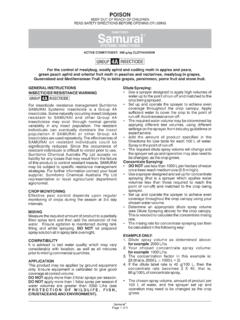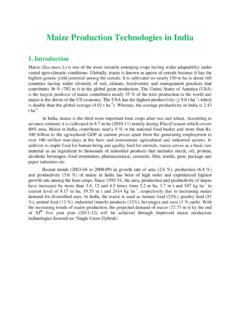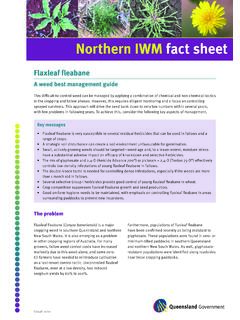Transcription of BrushOff 46401 0308 - Pest Genie
1 46401 / 0308 DuPont Brush-Off brush controller Page 1 of 7 Technical Information Active Constituent: 600 g/kg METSULFURON-METHYL GROUP B HERBICIDE Pack Sizes: 40 g 200 g READ SAFETY DIRECTIONS BEFORE OPENING OR USING For the control of certain brush and broadleaf species in native pastures, rights of way and commercial and industrial areas and for the control of certain broadleaf weeds in grass pastures and pasture renovations as per the Directions for Use SAFETY DIRECTIONS May irritate the eyes and skin. Avoid contact with eyes and skin. DO NOT inhale dust or spray mist. After use and before eating, drinking, or smoking, wash hands, arms and face thoroughly with soap and water. FIRST AID If poisoning occurs, contact a doctor or Poisons Information Centre. Phone Australia 13 11 26. MATERIAL SAFETY DATA SHEET For further information refer to the Material Safety Data Sheet that can be obtained from GENERAL INSTRUCTIONS Always add a surfactant/wetting agent.
2 (See section Use of Surfactant/Wetting Agent ). Allow weeds to recover from grazing before application. Docks and Sorrel in particular require fresh leaf growth for adequate uptake of chemical. Some grasses will be damaged in pasture sprayed with the product and biomass production may be reduced for several months. DuPont Brush-Off used on established Perennial phalaris and/or established Perennial cocksfoot may cause temporary yellowing and some stunting. DuPont Brush-Off can severely damage introduced grass species. DuPont Brush-Off does not control/damage Silvergrass (Vulpia spp.), Barley grass (Hordeum spp.), Brome grass (Bromus spp.) or Winter grass (Poa spp.). ALL grasses and legumes can be damaged and/or removed by a Brush-Off /glyphosate mixture. Legumes will be removed from pasture if over-sprayed with Brush-Off brush controller.
3 Some crops are extremely sensitive to low concentrations of this product. See Sprayer Clean-up section. Where treatment is delayed or where weeds are not actively growing due to adverse conditions, results may be slow to appear and weeds may only be stunted or suppressed. Instructions specific for brush and herbaceous weed control: Apply when bushes/plants are actively growing. Where treatment is delayed or bushes/plants are not actively growing due to adverse conditions (such as a period of prolonged dry weather) or if partial spray coverage occurs, results may be slow to appear and subsequent regrowth may occur. Should regrowth occur, re- treatment at the recommended rate is advised. Re- treatment of blackberries should only be undertaken once regrowth has reached one (1) metre tall - this may not be until two (2) years after the initial application.
4 For control of bushes previously sprayed with other brush control herbicides or for bushes which may have been burned or slashed ensure two (2) years has elapsed. Due to the widespread picking of blackberries by the public, it is recommended that the product is not applied to bushes bearing mature fruit. Instructions specific for treatment of pasture or pasture renovation: Sorrel seedlings may germinate after the break in the following year, particularly after cultivation. The ungerminated clover seed bank is not affected by Brush-Off application. Clover vigour is often increased in the year following application where seed banks are reasonable. The seed set of clover in the year of application of Brush-Off brush controller will DuPont Brush-Off brush controller 46401 / 0308 DuPont Brush-Off brush controller Page 2 of 7 be significantly reduced particularly from the Winter-Spring application.
5 This effect may impact on the clover seed bank therefore re- sowing may be necessary. Where clover seed banks are high re- sowing is not necessary. For pasture topping situations a combination of Brush-Off brush controller plus glyphosate can be used, however the Crop Rotation recommendations should be observed. Refer to the Directions for Use section of each product for the appropriate rate and critical comments for the target weed spectrum. RESISTANT WEEDS WARNING DuPont Brush-Off brush controller is a member of the sulfonylurea group of herbicides and has the inhibitor of the enzyme acetolactate synthase (ALS) mode of action. For weed resistance management, the product is a Group B herbicide. Some naturally-occurring weed biotypes resistant to the product and other Group B herbicides may exist through normal genetic variability in any weed population.
6 The resistant individuals can eventually dominate the weed population if these herbicides are used repeatedly. These resistant weeds will not be controlled by this product or other Group B herbicides. Since the occurrence of resistant weeds is difficult to detect prior to use, DuPont accepts no liability for any losses that may result from the failure of this product to control resistant weeds. To prevent, or at least minimise, the risk of resistant weeds occurring, use Brush-Off in tank mixes (if appropriate) and/or rotations with herbicides having different modes of action effective on the same weed species. Large numbers of healthy surviving weeds can be an indication that resistance is developing. Efforts should be taken to prevent seed set of these survivors. DO NOT make more than one application of Group B herbicide to a pasture in any one year.
7 If the user suspects that Group B resistant weed is present, this product or other Group B herbicides should not be used. Strategies to minimise the risk of herbicide resistance are available. Consult your farm chemical supplier, consultant, local Department of Agriculture or Primary Industries, or local DuPont representative. Spray Preparation DuPont Brush-Off is a dry flowable formulation to be mixed with water and applied as a spray. Partially fill the spray tank with water. Using the measuring cone provided measure the amount of product required for the volume to be sprayed. Add the correct amount of product to the spray tank with the agitation system engaged. Top up to the correct volume with water. THE MATERIAL MUST BE KEPT IN SUSPENSION AT ALL TIMES BY CONTINUOUS AGITATION. When prepared spray solutions have been allowed to stand, thoroughly re-agitate before using.
8 In tank mixes Brush-Off brush controller must be in suspension before adding the companion herbicide or surfactant. Before spraying calibrate equipment to determine the quantity of water necessary to uniformly cover the measured area to be treated. When tank mixing with glyphosate, DO NOT mix in a galvinised steel or unlined steel containers. Such tanks can react with glyphosate to produce hygrogen gas; this can form a combustible gas mixture, which may explode when ignited. Use of a Surfactant/ Wetting Agent ALWAYS ADD A SURFACTANT/WETTING AGENT. Instructions specific for brush and herbaceous weed control. If a specific surfactant/wetting agent is not listed in the Directions for Use table, or when mixing with glyphosate use a non-ionic surfactant (1,000 gac/L) at 100 mL/100 L of final spray volume (ie % volume/volume).
9 When an organosilicone penetrant (Pulse ) is recommended in the Directions for Use table and with all gasgun applications, use 10 mL/5 L or 200 mL/100 L of final spray volume (ie % volume/volume). When a mineral spray oil (eg Caltex Sprayplus ) is recommended in the Directions for Use table, use 1 L/100 L of final spray volume (ie 1 % volume/volume). Instructions specific for treatment of pasture and pasture renovation: Always add a non-ionic surfactant (1,000 gac/L) eg BS1000 or Chemwet 1000 at 200 mL/100 L of final spray volume ( % volume/volume). Compatibilities DuPont Brush-Off is compatible with the commonly used pasture herbicides MCPA amine, MCPA ester, 2,4-D amine, Lontrel , Starane , dicamba and the non-selective herbicide glyphosate. DuPont Brush-Off is compatible with the commonly used pasture insecticides chlorpyrifos (eg Lorsban ) and omethoate (eg Le-mat ).
10 Refer to the label of the other product(s) being mixed with Brush-Off brush controller, and follow any instructions and/or restrictions surrounding use. APPLICATION Handgun Application Spray foliage and canes until wet. Ensure coverage is uniform and complete. Use pressures of 550 750 kPa (80 -100 psi) depending on target species and size of bush. Use larger nozzles and higher pressures for largest bushes. For example: Size No. 4 or 5 spray nozzle: small individual bushes or broadleaf weeds - less than 1m high Size No. 5 or 6 spray nozzle: medium sized bushes 1-2 m high Size No. 7 or 8 spray nozzle: large bushes 2-3 m high or of a large diameter. NOTE: Use large spray nozzle/high volume for blackberry regrowth. Spray using a wide cone setting as much as possible. Use even, side-by-side spray pattern moving up from the base to the top of the bush as leaves are wet.














